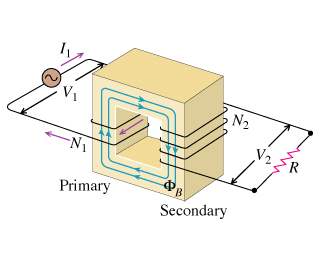About Transformer Voltage
What is Transformer Voltage?
 A transformer is a voltage changer. Most transformers are designed to either step voltage up or to step it down. Although some are used only to isolate one voltage from another. Voltage in the world different in the United States and Canada usually run on 110/120 and most of the rest of the world runs on 220/240 and industrial plant may use 440 to 480. The primary and secondary windings consist of aluminum or copper conductors wound in coils around an iron core and the number of turns in each coil will determine the voltage transformation of the transformer. Each turn of wire in the primary winding has an equal share of the primary voltage. The same is induced in each turn of the secondary. Therefore, any different in the number of turns in the secondary as compared to the primary will produce a voltage change. As in a step down transformer when there are fewer turns in the secondary winding than in the primary winding, the secondary voltage will be lower than the primary. In a step up transformer there are fewer turns in the primary windings than in the secondary winding, the secondary voltage will be higher than the secondary circuit. The primary winding is the winding which receives the energy: it is not always the high-voltage winding. When the primary winding and the secondary winding have the same amount of turns there is no change voltage, the ratio is 1/1 unity.
A transformer is a voltage changer. Most transformers are designed to either step voltage up or to step it down. Although some are used only to isolate one voltage from another. Voltage in the world different in the United States and Canada usually run on 110/120 and most of the rest of the world runs on 220/240 and industrial plant may use 440 to 480. The primary and secondary windings consist of aluminum or copper conductors wound in coils around an iron core and the number of turns in each coil will determine the voltage transformation of the transformer. Each turn of wire in the primary winding has an equal share of the primary voltage. The same is induced in each turn of the secondary. Therefore, any different in the number of turns in the secondary as compared to the primary will produce a voltage change. As in a step down transformer when there are fewer turns in the secondary winding than in the primary winding, the secondary voltage will be lower than the primary. In a step up transformer there are fewer turns in the primary windings than in the secondary winding, the secondary voltage will be higher than the secondary circuit. The primary winding is the winding which receives the energy: it is not always the high-voltage winding. When the primary winding and the secondary winding have the same amount of turns there is no change voltage, the ratio is 1/1 unity.
Common single-phase transformer voltage combination:
- 120 x 240 to 120/240
- 480 to 120/140
- 4160 to 240/480
- 277 to 120/240
- 2400 to 120/240
- 240 x 480 to 120/240
- 2400 to 240/480
This relationship between the number of turns in the secondary and primary is often called the voltage ratio or turns ratio. It is customary to specify the turns ratio by wiring the primary number first. In most transformers the high voltage winding is wound directly over the low voltage winding to create efficient coupling of the two windings. Other designs may have the high voltage winding wound inside, side-by-side or sandwiched between layers of the low voltage winding to meet special requirements. It may be desirable to change the ratio in order to get rated output voltage when the incoming voltage is slightly different than the normal voltage. For example, suppose have a transformer with a 4 to 1 turns ratio. With 480 volts input, the output out be 120 volts. Suppose the line voltage is less than the normal or 456 volts. This would produce an output voltage of 114 volts which is not desirable. By placing a tap in the primary winding, we could change the turns ratio so that with 456 volts input we could still get 120 volts output. This is called primary output voltage tap and standard transformers may have from two to six taps for the purpose of the adjusting to actual the voltages.
- Go back to the previous page.
- Use the search bar at the top of the page to search for your products.
- Follow these links to get you back on track!
Store Home | My Account

 United States
United States